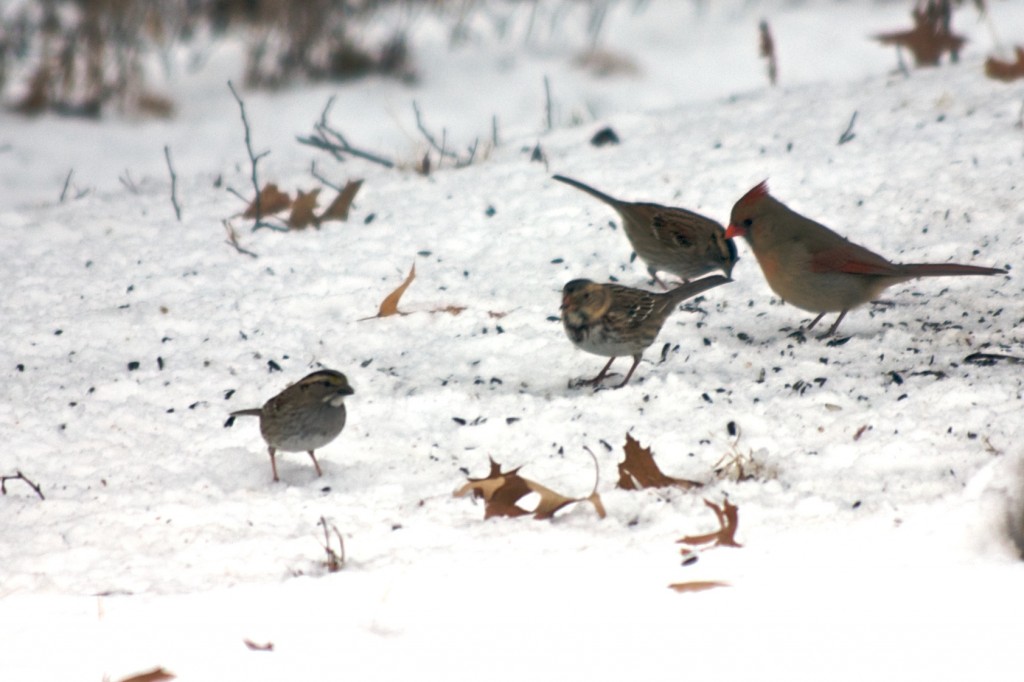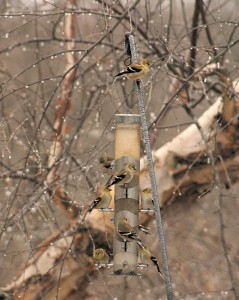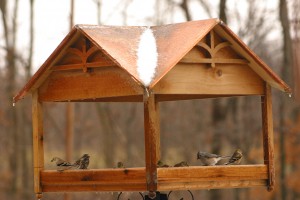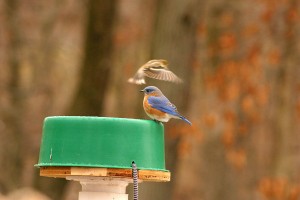Spend the Winter in Balmy Southwestern Illinois!

A Harris' Sparrow, an uncommon visitor from the western plains, feeds at a backyard feeder station with two White-throated Sparrows, winter visitors from their northern breeding grounds, and a female Northern Cardinal, one of our year-round resident passerine species. Photo courtesy Pen DauBach, Clifftop.
Just about the time some of us begin to envision a wintertime escape to warmer areas, our own “snowbirds” take up residence with us, making winter homes in the warmth of our balmy climate. They join our year-round resident birds, and all benefit from their ability to find sufficient food and shelter in cold weather months.
Geese and ducks migrate here, but will move deeper south as winter becomes colder and freezes ponds and streams. Long after summer breeders, such as orioles, tanagers and hummingbirds, have left their breeding grounds here and returned to winter territories in Central and South America an influx of hardy birds arrive from northern areas, joining our year-round residents, to eke out the winter in our warmth.
A number of passerines – perching birds – arrive in our area in late fall and early winter, staying only through spring, when they again migrate north. During their winter stay, passerines can be found, sometimes in large flocks, in fields, forest edges, near ponds, and at backyard bird feeding stations.
Although bird migration is a central facet of avian life, scientifically based understanding of the phenomenon only began in the 19th century. People certainly noticed the annual appearances and disappearances of birds, but attributed this to other means, such as hibernation, as in the long-held belief that swallows burrowed into mud under ponds for winter roosts, sleeping there in a torpid state until springtime warmth called them back to sunny skies.

American Goldfinches flock to a wintertime feast; their drab winter plumage belies one of their common name -- "wild canaries" -- descriptive of their summer feathers of bright yellow highlighted with black and white. Photo courtesy Paul Feldker, Clifftop.
The migration patterns of many birds have been well studied and mapped. Today’s technology even allows us to watch real-time migration instances as radar imagery depicts the lift offs of thousands of migrants concentrated in various stopover points along their routes. Nearly all passerines migrate at night, lifting off shortly after dusk, and then landing at dawn many miles further along their route to feed and rest. The nighttime flight keeps them safe from predators, such as hawks, who migrate by day, saving energy by soaring on thermal heat created by the sun. Answers to the ‘why’ of migration center on cost-benefit analysis that, in evolutionary biological terms, equates to reproductive success.
As the breeding season is preceded by territorial claims and defense, it seems counterintuitive that birds would abandon hard-won territories. But, for birds that rely on insect foods, leaving in winter is their only survival strategy as the number of bug bites plummets along with the temperatures. Many species of birds that remain with us through the year, and those that migrate to us for the winter, switch from their summer insect-rich diet to one based on available seeds, fruits, and over-wintering stages of insects, such as eggs or larvae.
The alternate strategy would be to stay year-round and establish permanent territories on winter grounds with favorable weather all year long. In other words, why don’t tanagers, orioles and all the additional species that migrate here to breed in the summer, just stay in their Central and South American wintering grounds? And, if White-crowned Sparrows can happily spend the winter here, why do they abandon this area to head north for breeding?
It’s a matter of reproductive success and the food sources that increase success.
Birds that breed in temperate areas generally produce more eggs per nesting – four to six or even more – than birds that breed in the tropics which usually produce only two to three eggs per clutch. Birds in temperate areas also breed more frequently and more nestlings survive due to fewer nest predators. Having separate breeding and winter ranges results in greater reproductive success through the exploitation of seasonally high food supplies in the north — all those summertime bug bites – and consistent wintertime food sources that make migrating away from breeding territory worth the energy costs.

Another wintertime visitor to our area is this Purple Finch female. Her heavily streaked breast and sturdy beak help identify and differentiate her from the American Goldfinches and Tufted Titmouse also attracted to this feeding station. Photo courtesy Paul Feldker, Clifftop.
Variation occurs even within the cost-benefit distance of migration. Long distance migrants, such as orioles and tanagers, travel across continents, others, like our wintertime White-crowned and White-throated Sparrows and Dark-eyed Juncoes, stay within the confines of a continent. But the breeding imperative also seems to drive actual distances within some species. Dark-eyed Junco males, undoubtedly eager to stake first claims to next year’s breeding territories, winter in the most northerly stretches of the species’ wintering grounds, while females spend the winter in the southernmost areas.
A few bird species rely on back-and-forth short distance trips, rather than full migration journeys. Our area is at the northern edge of Eastern Bluebirds’ year-round range, and “our” Bluebirds are joined during winter by members of their species that breed as far north as Hudson Bay. But in very severe stretches of cold, both sets of Bluebirds will undertake short hops to the south, returning as the weather allows, and, sometimes, taking several such respites through the winter season. A few species, like American Robin, live as migrants in popular imagination as their first sighting on lawns is heralded as a “harbinger of spring.” Our area, however, is smack in the middle of American Robins’ year round range and they do not migrate away from us. Rather, they abandon their search for earthworms in yards, turning to a winter diet of fruits and berries gleaned in woodlands and field edges. Other birds so change their wintertime plumage that they are mistakenly taken as a migratory species. For example, people may not realize that the year round resident American Goldfinch flocks in drab wintertime dull colors are the same birds as the bright yellow “wild canaries” of summer.

Eastern Bluebird male enjoying a heated bird water stop as an American Goldfinch takes flight. Bluebirds generally are year round residents here, but may take short "vacation hops" to the south during fiercely cold outbreaks. Photo courtesy Paul Feldker, Clifftop.
While we have fewer total bird species with us during the winter months, in some cases the number of species within a family group is higher in winter than summer thanks to the “snowbirds” that come south to spend the cold months with us. Our area’s bird life is particularly enriched by winter resident sparrow species including White-crowned Sparrow, White-throated Sparrow, American Tree Sparrow, Fox Sparrow, LeConte’s Sparrow, Swamp Sparrow, and Savannah Sparrow. In addition to sparrows, our winter passerine flocks regularly include Dark-eyed Juncoes, Purple Finches, Lapland Longspurs, Smith’s Longspurs, Pine Siskins and two blackbird species, Rusty Blackbird and Brewer’s Blackbird. More rarely, we may receive winter migrants from the west, such as Harris’ Sparrow and Western Meadowlark, or more northerly winter resident species including Common Redpoll, Snow Bunting, and Evening Grosbeak.
Many, but not all, of these bird species will visit bird feeding stations, joining our year round resident Northern Cardinals, Chickadees, Tufted Titmouse, American Goldfinches and other backyard birds as they all flock for good winter food and survival. They greatly enrich the viewing experience for people as they peer out of windows, watching and enjoying the variety wintertime can bring.
CLIFFTOP, a local nonprofit organization, is focused on preserving and protecting area bluff lands. A version of this article appeared in the 18 December 2015 edition of the Monroe County Independent.
© 2015 all content rights reserved Clifftop NFP
Comments are currently closed.
